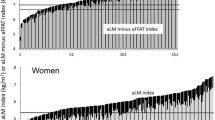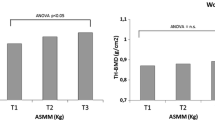Abstract
Background
How body composition, specifically skeletal muscle mass, compares in Mexican elderly to other ethnic groups has not previously been reported. We tested the hypothesis that older adults from Northwest Mexico (Mex) would have similar total appendicular skeletal muscle (TASM) compared with New York dwelling Caucasians (Cauc) and African-Americans (AA).
Methods
Two hundred and eighty nine Mex (135 males and 154 females), 166 AA (36 males and 130 females) and 229 Cauc (64 males and 165 females), aged 60–98 years were assessed. Total and regional fat and lean tissues were measured by whole-body dual energy X-ray absorptiometry where TASM is the sum of arm and leg bone-free and fat-free lean tissue. Differences in TASM were tested by ANCOVA, with age, height, and body mass index (BMI) as covariates.
Results
TASM adjusted for ethnicity, age, height and BMI, were 22.6 ± 0.2 kg and 17.8 ± 0.1 kg for males and females, respectively (p<0.001). Among males with similar age, height, and BMI, Mex had less TASM compared with AA and Cauc (p<0.001). Total body fat and truncal fat were higher (p< 0.001) and FFM lower (p<0.001) in Mex compared to both AA and Cauc males after adjusting for age and BMI. Among females, Mex had higher total and truncal fat (p<0.001) after adjusting for age and BMI, and significantly lower TASM (p<0.001) after adjusting for age, height, and BMI compared to AA and Cauc females.
Conclusions
Elderly Mex have a different body composition compared with AA and Cauc of a similar BMI and age. Mex have significantly less TASM with greater total and truncal fat. In the long-term, Mex elderly may be at greater risk for sarcopenic obesity compared to other ethnic groups.
Similar content being viewed by others
References
Kyle UG, Genton L, Hans D, Karsegard VL, Michel JP, Slosman DO, Pichard C. Total body mass, fat mass, fat-free mass, and skeletal muscle in older people: crosssectional differences in 60-year-old persons. J Am Geriatr Soc 2001;49:1633–1640.
Raguso CA, Kyle U, Kossovsky MP, Roynette C, Paoloni-Giacobino A, Hans D, et al. A 3-year longitudinal study on body composition changes in the elderly: role of physical exercise. Clin Nutr 2006;25:573–580.
He Q, Heo M, Heshka S, Wang J, Pierson RN Jr, Albu J, et al. Total body potassium differs by sex and race across the adult age span. Am J Clin Nutr 2003;78:72–77.
Kyle UG, Genton L, Hans D, Karsegard L, Slosman DO, Pichard C. Age-related differences in fat-free mass, skeletal muscle, body cell mass and fat mass between 18 and 94 years. Eur J Clin Nutr 2001;55:663–672.
Gallagher D, Ruts E, Visser M, Heshka S, Baumgartner RN, Wang J, et al. Weight stability masks sarcopenia in elderly men and women. Am J Physiol Endocrinol Metab 2000;279:366–375.
Cook Z, Kirk S, Lawrenson S, Sandford S. Use of BMI in the assessment of undernutrition in older subjects: reflecting on practice. Proc Nutr Soc 2005;64:313–317.
McCargar L. New insights into body composition and health through imaging analysis. Can J Diet Pract Res 2007;68:160–165.
Romero-Corral A, Somers VK, Sierra-Johnson J, Thomas RJ, Collazo-Clavell ML, Korinek J, et al. Accuracy of body mass index in diagnosing obesity in the adult general population. Int J Obes 2008;32:959–966.
Janssen I, Heymsfield SB, Wang ZM, Ross R. Skeletal muscle mass and distribution in 468 men and women aged 18–88 yr. J Appl Physiol 2000;89:81–88.
Morley JE, Baumgartner RN, Roubenoff R, Mayer J, Nair KS. Sarcopenia. J Lab Clin Med 2001;137:231–243.
Roubenoff R. Origins and clinical relevance of sarcopenia. Can J Appl Physiol 2001;26:78–89.
Janssen I. Influence of sarcopenia on the development of physical disability: the Cardiovascular Health Study. J Am Geriatr Soc 2006;54:56–62.
Bortz WM II. A conceptual framework of frailty: a review. J Gerontol A Biol Sci Med Sci 2002;57:283–288.
Gallagher D, Visser M, De Meersman RE, Sepúlveda D, Baumgartner RN, Pierson RN, et al. Appendicular skeletal muscle mass: effects of age, gender, and ethnicity. J Appl Physiol 1997;83:229–239.
Casas YG, Schiller BC, Desouza CA, Seals DR. Total and regional body composition across age in healthy Hispanic and white women of similar socioeconomic status. Am J Clin Nutr 2001;73:13–18.
Deurenberg P, Yap M, van Staveren WA. Body mass index and percent body fat: a meta analysis among different ethnic groups. Int J Obes Relat Metab Disord 1998;22:1164–1171.
Obisesan TO, Aliyu MH, Bond V, Adams RG, Akomolafe A, Rotimi CN. Ethnic and age-related fat free mass loss in older Americans: the Third National Health and Nutrition Examination Survey (NHANES III). BMC Public Health 2005;5:41.
Wu CH, Heshka S, Wang J, Pierson RN Jr, Heymsfield SB, Laferrère B, et al. Truncal fat in relation to total body fat: influences of age, sex, ethnicity and fatness. Int J Obes 2007;31:1384–1391.
Heymsfield SB, Smith R, Aulet M, Bensen B, Lichtman S, Wang J, Pierson RN Jr. Appendicular skeletal muscle mass: measurement by dual-photon absorptiometry. Am J Clin Nutr 1990;52:214–218.
Hansen RD, Raja C, Aslani A, Smith RC, Allen BJ. Determination of skeletal muscle and fat-free mass by nuclear and dual-energy x-ray absorptiometry methods in men and women aged 51–84 y. Am J Clin Nutr 1999;70:228–233.
Fernández JR, Heo M, Heymsfield SB, Pierson RN Jr, Pi-Sunyer FX, Wang ZM, et al. Is percentage body fat differentially related to body mass index in Hispanic Americans, African Americans, and European Americans? Am J Clin Nutr 2003;77:71–75.
Gallagher D, Heymsfield SB, Heo M, Jebb SA, Murgatroyd PR, Sakamoto Y. Healthy percentage body fat ranges: an approach for developing guidelines based on body mass index. Am J Clin Nutr 2000;72:694–701
Deurenberg-Yap M, Schmidt G, van Staveren WA, Deurenberg P. The paradox of low body mass index and high body fat percentage among Chinese, Malays and Indians in Singapore. Int J Obes Relat Metab Disord 2000;24:1011–1017.
St-Onge MP. Relationship between body composition changes and changes in physical function and metabolic risk factors in aging. Curr Opin Clin Nutr Metab Care 2005;8:523–528.
Gallagher D, Heymsfield SB. Muscle distribution: variations with body weight, gender, and age. Appl Radiat Isot 1998;49:733–734.
Doherty TJ. Invited review: Aging and sarcopenia. J Appl Physiol 2003;95:1717–1727.
Morley JE, Baumgartner RN, Roubenoff R, Mayer J, Nair KS. Sarcopenia. J Lab Clin Med 2001;137:231–243.
Marcell TJ. Sarcopenia: causes, consequences, and preventions. J Gerontol A Biol Sci Med Sci 2003;58:M911–M916.
Baumgartner RN, Waters DL, Gallagher D, Morley JE, Garry PJ. Predictors of skeletal muscle mass in elderly men and women. Mech Ageing Dev 1999;107:123–36.
Arden NK, Spector TD. Genetic influences on muscle strength, lean body mass, and bone mineral density: a twin study. J Bone Miner Res 1997;12:2076–2081.
Gerace L, Aliprantis A, Russell M, Allison DB, Buhl KM, Wang J, et al. Skeletal differences between black and white men and their relevance to body composition estimates. Am J Hum Biol 1994;6:255–262.
Reid KF, Naumova EN, Carabello RJ, Phillips EM, Fielding RA. Lower extremity muscle mass predicts functional performance in mobility-limited elders. J Nutr Health Aging 2008;12:493–498.
Vincent KR, Braith RW, Feldman RA, Magyari PM, Cutler RB, Persin SA, et al. Resistance exercise and physical performance in adults aged 60 to 83. J Am Geriatr Soc 2002;50:1100–1107.
Skelton DA, Young A, Greig CA, Malbut KE. Effects of resistance training on strength, power, and selected functional abilities of women aged 75 and older. J Am Geriatr Soc 1995;43:1081–1087
Rolland Y, Czerwinski S, Van Kan Abellan G, Morley JE, Cesari M, Onder G, et al. Sarcopenia: its assessment, etiology, pathogenesis, consequences and future perspectives. J Nutr Health Aging 2008;12:433–450.
Baumgartner RN, Wayne SJ, Waters DL, Janssen I, Gallagher D, Morley JE. Sarcopenic obesity predicts instrumental activities of daily living disability in the elderly. Obes Res 2004;12:1995–2004.
Author information
Authors and Affiliations
Corresponding author
Rights and permissions
About this article
Cite this article
Alemán-Mateo, H., Lee, S.Y., Javed, F. et al. Elderly Mexicans have less muscle and greater total and truncal fat compared to African-Americans and Caucasians with the same BMI. J Nutr Health Aging 13, 919–923 (2009). https://doi.org/10.1007/s12603-009-0252-1
Received:
Accepted:
Published:
Issue Date:
DOI: https://doi.org/10.1007/s12603-009-0252-1




